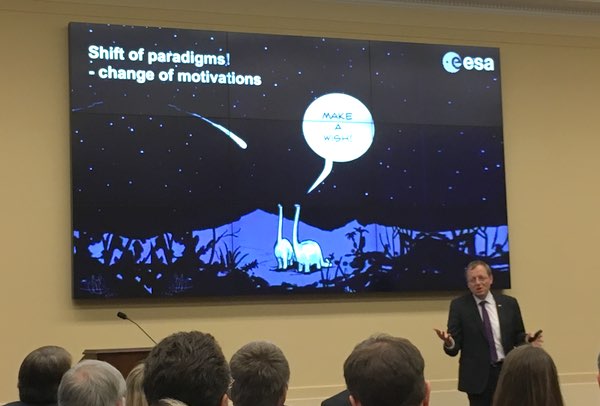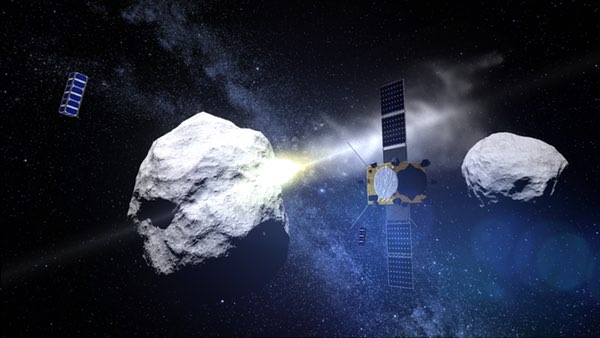AIM misses the funding target, for nowby Jeff Foust
|
| “Rosetta was a bold mission whose spirit we believe must be continued with AIDA and its AIM mission,” scientists wrote in a November letter seeking funding for AIM. |
The good news for those programs is that ministers came through in the end: they agreed to extend ESA’s participation on the ISS, a deal which includes providing a second service module for NASA’s Orion spacecraft, and they found the additional money for ExoMars. They also hailed, at the post-meeting press briefing, the various other accomplishments from the meeting, including ongoing support for Earth observation and navigation spacecraft, and development of the Ariane 6 launch vehicle. This was all part of a broader strategy promoted by ESA’s director-general, Jan Wörner, called “Space 4.0 for a United Space in Europe.” (“Space 4.0,” a term commonly used by Wörner, plays off the concept in Germany of “Industry 4.0” that takes into account changes in information technology and other capabilities in manufacturing.)
ESA did not get everything that it wanted from the ministerial meeting, though. The meeting ended with no money for the agency’s planned Asteroid Impact Mission (AIM). That spacecraft was part of a broader joint effort with NASA called Asteroid Impact and Deflection Assessment (AIDA). AIM would visit the near Earth asteroid Didymos and its smaller moon, dubbed “Didymoon,” studying them in detail. NASA’s planned Double Asteroid Redirection Test (DART) spacecraft would then impact Didymoon, with AIM observing the impact and measuring by how much the impact changed the small asteroid’s orbit.
AIM had support from scientists for both its scientific mission as well as its role supporting planetary defense. In mid-November, a group of 100 scientists unveiled an “I Support AIM” campaign, including a letter to ESA calling for funding of the mission, linking it to ESA’s recently completed, and highly successful, Rosetta comet mission.
“Rosetta was a bold mission whose spirit we believe must be continued with AIDA and its AIM mission,” they wrote. “AIM is the ideal test-bed for new technologies and the perfect stepping stone toward more complex deep space missions.”
ESA’s ministers disagreed, declining to fund the mission. In a blog post two days after the meeting, Wörner called AIM “an example of ESA at its absolute best: daring, innovative and ambitious all at once,” but one that failed to win support during long negotiations over ESA’s budget.
“Although, in the beginning, very promising subscriptions were given, the withdrawal of the biggest single amount at the very last minute proved devastating to an important mission with great potential for worldwide visibility,” he wrote, referring to the contributions from individual member nations for AIM. “Ultimately—and this I very much regret—the difficult discussions among member states and a focus on direct applications and short-term return led inevitably to a situation in which I had no choice but to announce the proposal’s cancellation.”
 ESA director-general Jan Wörner discusses the outcome of the recent ministerial meeting at a Space Transportation Association luncheon December 9 on Capitol Hill. (credit: J. Foust) |
Wörner, speaking last Friday at a Space Transportation Association luncheon in Washington, offered more details about how AIM lost out. He mentioned what is known as “Document 100,” which lists the various programs under consideration and which is used by member nations to specify their contributions to them.
“With AIM, we had the situation that one country—I will not name that it was Germany—gave 35 million [euros] at the beginning,” he said. That was less than anticipated, he added. “We needed about 60 million from Germany.”
| “I’m fighting for it because I think too important, and taxpayers expect that from a space agency, that they do something like this,” Wörner said. |
Other countries stepped up with contributions to AIM, he said, including smaller ESA members like Luxembourg and Romania, but the program was still running short of what it needed. “Unfortunately, after all the calculations of all the different programs, Germany had to withdraw its part, so instead of getting more, they said, ‘Unfortunately, we have to withdraw the 35 million.’”
That withdrawal, Wörner said, put AIM below a funding threshold required for it to continue. “So I had to say, which was very difficult for me, ‘I’ll stop it right now, but I’m convinced I will do it,’” he said.
In his speech, Wörner said he could continue to flight to win funding for AIM, citing its importance to planetary defense in particular. “Bruce Willis might not be ready to do it again,” he joked, referring to one of the stars of the asteroid impact movie Armageddon. “I’m fighting for it because I think too important, and taxpayers expect that from a space agency, that they do something like this.”
How he planned to fight for AIM was less clear. The next ministerial meeting isn’t until 2019, too late to preserve AIM’s current mission, which calls for an October 2020 launch to arrive at Didymos in May 2022. Wörner, though, suggested there might be something possible in the near term to “rescue” the mission. Such a rescue would likely be needed to preserve NASA’s own DART mission: that impactor mission would be less useful without a companion spacecraft to observe the impact and record its effects. (In a talk about DART at the American Geophysical Union’s Fall Meeting Monday in San Francisco, Andy Cheng of the Johns Hopkins University’s Applied Physics Lab said that work on DART remained on track at least through the mission’s next review in March.)
“I see some chances that we can still do it. We have a very tight calendar for the launch, but we have some weeks to rescue, and I’m working on it,” Wörner said. “I think AIM is not lost. We need to do something. Again, I’m convinced that this is a good mission. It’s a cheap mission, but it’s a good one.”
